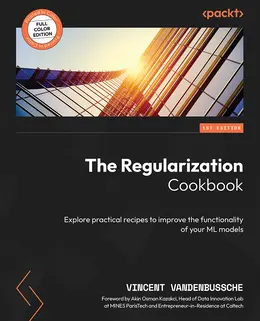The Regularization Cookbook

eBook Details:
- Paperback: 424 pages
- Publisher: WOW! eBook (July 31, 2023)
- Language: English
- ISBN-10: 1837634084
- ISBN-13: 978-1837634088
eBook Description:
The Regularization Cookbook: Methodologies and recipes to regularize nearly any machine learning and deep learning model using cutting-edge technologies such as Stable Diffusion, Dall-E and GPT-3
Deploying machine learning solutions is all about getting robust results on new, unseen data. To achieve such results, one way is regularization. Regularization can take many forms and can be used in many ways, and not all methods apply to all cases. This book aims at providing the right tools and methods to handle any case properly, with ready-to-use working codes as well as theoretical explanations whenever possible.
After an introduction to regularization and methods to diagnose when to use it, we will start implementing regularization techniques on linear models such as linear and logistic regression, and tree-based models such as random forest and gradient boosting.
The The Regularization Cookbook book will then introduce specific regularization methods based on data. High cardinality features and imbalanced datasets may require specific regularization methods that will be explored.
- How to diagnose overfitting properly and when regularization is needed
- Regularizing common linear models such as logistic regression
- Get a deeper knowledge of regularizing tree-based models such as XGBoost
- Leverage structured data to regularize ML models
- Learn general techniques to regularize deep learning models
- Discover specific regularization techniques for NLP problems using Transformers
- Understand the regularization in Computer Vision models and CNN architectures
- Apply cutting-edge computer vision regularization with generative models
In the last five chapters, the book will cover regularization for deep learning models. After reviewing general methods that apply to any type of neural network, the book will dive into more NLP-specific methods for RNNs and transformers, as well as using BERT or GPT-3. We will close with regularization for Computer Vision, covering CNN specifics, as well as the use of generative models such as Stable Diffusion and Dall-E.
